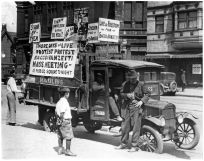a review of
Immigrants Against the State: Yiddish & Italian Anarchism in America by Kenyon Zimmer. University of Illinois Press, 2015, 300 pp.
The campaign in the 1920s to save Sacco and Vanzetti from execution brought anarchists to national attention, but not the fact that they were part of a large community of comrades in Boston.

Even after decades of study and analysis, the history of anarchism in the United States often feels incomplete. Most histories present a succession of key events and prominent people, inevitably with a heavy emphasis on English language sources.
As a result, the non-English speaking movements—an important component of anarchism in the U.S.—have received scant attention. In this context, Kenyon Zimmer’s Immigrants Against the State is an exciting contribution to our understanding of anarchist history in the U.S. as it sheds new light on previously explored topics and uncovers many forgotten stories.
The book explores the Lower East Side of New York City, the Italian district of Paterson, NJ., and the North Beach area of San Francisco. Three chapters explore the anarchist milieu in these areas, focusing on the anarchist publications, groups, and activities that took place.
The cities were all important hubs of anarchist activity, both on a national level as well as internationally, with key anarchist publications such as the Yiddish Fraye Arbeter Shtime and the Italian La Questione Sociale being published there.
Following the localized explorations, Zimmer discusses how anarchists responded to World War I, the rise of communism and the Red Scare in the United States following the war, and the crisis anarchism faced in response to the growth of communism and fascism.
There was an exchange of ideas across cultures and borders, resulting in a movement that was truly international in character. Far from being a simple European import, anarchism in the United States involved the transmission of ideas elsewhere, with periodicals produced in the United States being read around the world and an almost constant flow of anarchists across borders providing further opportunity for exchange.
Anarchists, including Yiddish and Italian anarchists in the United States, saw themselves through an international lens and challenged notions of citizenship and nationalism. In its place, anarchists developed a “cosmopolitanism” that set itself against the nationalisms of both the United States and their countries of origin.
Zimmer argues that the Yiddish and Italian movements developed distinctive cultures based on their ideals, producing publications, events, institutions, groups, and traditions that provided an alternative form of identification to nationalism.
As a contemporary study, Immigrants Against the State develops paths of inquiry that are often missing from older studies of anarchism. For example, Zimmer provides an insightful exploration of how Yiddish and Italian speaking anarchists related to questions of gender and race, both within their own movement and externally.
This encourages a more nuanced understanding of anarchism in the United States. Zimmer examines how the Italian anarchists tended not to include women in their organizations and didn’t offer them meaningful roles, despite women providing essential labor in the family and in some cases even forming their own women’s groups. As for the Yiddish movement, as many as one-third of participants were women, but there remained a clear gendered division of labor.
Some of the most interesting discussions in the book center around race, an area that has often been ignored in anarchist histories. Zimmer writes that Yiddish anarchists published critiques of American racism, including an early Yiddish translation of work by black sociologist and civil rights activist, W.E.B. Du Bois.
Italian anarchists were even more critical of racism, publishing regular updates about violence against African Americans as well as critiques of racism. However, both groups were limited in challenging racism by their linguistically and culturally tight-knit communities and relative isolation. In contrast to anarchists on the East Coast, Zimmer explores how anarchists in San Francisco created a more multiracial space, with European anarchists taking stands against anti-Asian racism and working with Japanese and Indian anarchists who immigrated to the city.
Immigrants Against the State challenges some conventional assumptions about anarchism in the United States. Importantly, it presents a wealth of evidence showing that immigrants who came to the United States often didn’t bring anarchism with them, but rather that they became anarchists once they arrived there, after seeing the conditions in the factories and experiencing anti-immigrant discrimination.
Zimmer argues that anarchism wasn’t a minority movement within immigrant communities, but that it had substantial appeal. For example, in Paterson, the anarchist newspaper, La Questione Sociale, had a circulation of 1,000 out of a population of 5,000. Finally, Zimmer makes a convincing argument that anarchism’s decline in the United States was due in large part to immigration restrictions which deprived it of new recruits. This differs somewhat from other interpretations that emphasize the role of repression.
For those interested in the history of anarchism in the United States, Zimmer’s book is essential reading. By focusing on previously untold stories and making extensive use of foreign language sources, Immigrants Against the State broadens our collective understanding.
Furthermore, with its methodology and new modes of inquiry, it is a model for how contemporary anarchist histories can be written. However, as is the case with all history, it is an open question as to what anarchists in the present can learn from the past, but if nothing else, Immigrants Against the State paints a vivid and rich picture of what a vibrant anarchist movement can look like.
